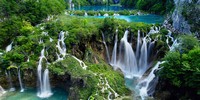CROATIA
general informations
Croatia Geographical position:
Croatia extends from the furthest eastern edges of the Alps in the north-west to the Pannonian lowlands and the banks of the Danube in the east; its central region is covered by the Dinara mountain range, and its southern parts extend to the coast of the Adriatic Sea.
Croatia Surface:
the mainland covers 56,542 km2, and the surface of the territorial sea is 31,067 km2.
Croatia Population:
4,437,460 inhabitants; composition of population: the majority of the population are Croats; national minorities are Serbs, Slovenes, Hungarians, Bosnians, Italians, Czechs and others.
System of government: multi-party parliamentary republic.
Croatian Capital:
Zagreb (779,145 inhabitants), the economic, traffic, cultural and academic centre of the country.
Croatia Coastline:
5,835 km of which 4,058 km comprise a coastline of islands, solitary rocks and reefs. Number of islands, solitary rocks and reefs: 1,185; the largest islands are Krk and Cres; there are 50 inhabited islands.
Croatia Highest peak:
Dinara: 1,831 m above sea level.
Croatia Climate:
There are two climate zones; a temperate continental climate, locally also a mountainous climate, prevails in the interior, whereas a pleasant Mediterranean climate prevails along the Adriatic coast, with an overwhelming number of sunny days, dry and hot summers, mild and humid winters; average temperature in the inland: January 0 to 2°C, August 19 to 23°C; average temperature at the seaside: January 6 to 11°C, August 21 to 27 °C; the temperature is about 12°C in winter, and 25°C in summer.
Croatia Currency:
kuna (1 kuna = 100 lipa). Foreign currency can be exchanged in banks, exchange offices, post offices, travel agencies, hotels, camps, marinas; cheques can be cashed in banks.
Croatia extends from the furthest eastern edges of the Alps in the north-west to the Pannonian lowlands and the banks of the Danube in the east; its central region is covered by the Dinara mountain range, and its southern parts extend to the coast of the Adriatic Sea.
Croatia Surface:
the mainland covers 56,542 km2, and the surface of the territorial sea is 31,067 km2.
Croatia Population:
4,437,460 inhabitants; composition of population: the majority of the population are Croats; national minorities are Serbs, Slovenes, Hungarians, Bosnians, Italians, Czechs and others.
System of government: multi-party parliamentary republic.
Croatian Capital:
Zagreb (779,145 inhabitants), the economic, traffic, cultural and academic centre of the country.
Croatia Coastline:
5,835 km of which 4,058 km comprise a coastline of islands, solitary rocks and reefs. Number of islands, solitary rocks and reefs: 1,185; the largest islands are Krk and Cres; there are 50 inhabited islands.
Croatia Highest peak:
Dinara: 1,831 m above sea level.
Croatia Climate:
There are two climate zones; a temperate continental climate, locally also a mountainous climate, prevails in the interior, whereas a pleasant Mediterranean climate prevails along the Adriatic coast, with an overwhelming number of sunny days, dry and hot summers, mild and humid winters; average temperature in the inland: January 0 to 2°C, August 19 to 23°C; average temperature at the seaside: January 6 to 11°C, August 21 to 27 °C; the temperature is about 12°C in winter, and 25°C in summer.
Croatia Currency:
kuna (1 kuna = 100 lipa). Foreign currency can be exchanged in banks, exchange offices, post offices, travel agencies, hotels, camps, marinas; cheques can be cashed in banks.




 0038523394636
0038523394636



